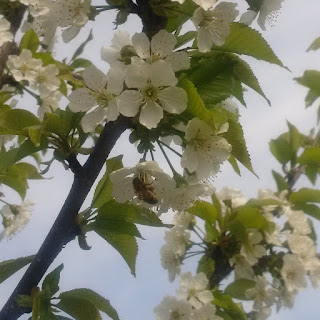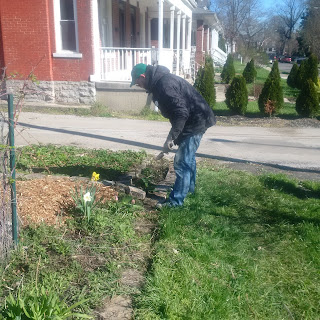It’s been a little lonely at the Stoddart Avenue Community Garden the last few weeks – as it is every April. The mornings are cold and the skies cloudy. However, our cherry trees looked SPECTACULAR a few weeks ago and attracted lots of bees. I look a lot of photos. Little cherries, strawberries and raspberries are already forming – a little early in my book. Our berries do not look as thick as in past years and I’m a little concerned that this might not be the best year to have a berry festival in early June as a fundraiser. We may have barely enough berries for ourselves;-) Our peach trees looked to have survived the March freeze, but when I was staking two of the leaning trees today, I noticed some freeze damage on the leaves. Sigh.
Last Saturday, I left on time and didn’t do that much. I planted some onions, lettuce, leeks, beets, turnips, cilantro and parsley, watered everything, and transplanted a some coneflowers (from my backyard) and a few perennials that I picked up during the annual DeMonye’s perennial sale. (I really need to pick up some cat mint and, darn it, didn’t write it down and bought a couple of everything else . . .). I didn’t assign any chores for April (because we had two groups of volunteers), but the grass was looking a little tall. Heroic Ken (in addition to donating a brand spanking new green gas mower) also donated an older reel mower (which I sharpened a few weeks ago and put in our shed). I took it out and tried to mow our lawn. Darn that Stan. He did such a fabulous job aerating and tending our lawn over the last two years that the grass was too tall and thick for me to easily mow it. It took me forever to mow just the front lawn and I didn’t even try to do much of the side yard (aka Block Watch lot).
On Wednesday, I watered some more. The rest of the country (and state) may be getting plenty of rain, but the drought has started early on the Near East Side. We haven’t gotten at least an inch of rain per week in several weeks. Alexi and Isaiah came by. Alexi made the mistake of asking if there was anything I needed. Since you ask . . . . . (which I’m certain that he’ll never do again), I asked him to mow the lawn. It was looking pretty shaggy. He agreed and started by mowing the Block Watch lot next door. He had met Block Watch Barb earlier in the week and she told him how the Block Watch (i.e., mostly her and her heroic husband Frank) mow the two corner lots most weeks. I had planned to only stay about 45 minutes, but I could hardly leave while he was still mowing. (We stow the mower in a neighbor’s shed and I have one of the only keys). Meanwhile, Isaiah started preparing the soil in their plot (by digging out the ever present bricks that we are still digging out by hand NINE years after breaking ground) and planting some seedlings and seeds. Since I had to stick around, I planted some more flowers from the flats I purchased at the DeMonye’s sale. I also weeded a few of the flower beds.
Little Jaden from across the street then came over to start planting in his own bed (now that he's finally six). His older sister Micayla has gardened with us since she was his age, but decided that she is now too cool to get dirty. So, he picked one of the platform raised beds (which did not have any weeds in it) and only wanted to plant fruit. It's too early for melons, but against my better judgment, we transplanted a row of some volunteer strawberries (from outside our patch). I also talked him into carrots and beets. His father likes peppers, so we'll plant some of them eventually. He vetoed lettuce and greens. Then, he watered everything in three times. (Most kids like to water, but a full watering can weighs almost as much as he does). Amy also stopped by with her husband to water her seedlings. Finally, when I got home at dusk, I mowed my own yard with my reel mower.
Little Jaden from across the street then came over to start planting in his own bed (now that he's finally six). His older sister Micayla has gardened with us since she was his age, but decided that she is now too cool to get dirty. So, he picked one of the platform raised beds (which did not have any weeds in it) and only wanted to plant fruit. It's too early for melons, but against my better judgment, we transplanted a row of some volunteer strawberries (from outside our patch). I also talked him into carrots and beets. His father likes peppers, so we'll plant some of them eventually. He vetoed lettuce and greens. Then, he watered everything in three times. (Most kids like to water, but a full watering can weighs almost as much as he does). Amy also stopped by with her husband to water her seedlings. Finally, when I got home at dusk, I mowed my own yard with my reel mower.
 On Friday, Seth from the City Land Bank, sent us all a hateful email threatening to terminate lot licenses (aka leases). As I have heard over the years, some community gardens are not as conscientious as we are about keeping their lawns mowed. Seth had inspected most of the gardens on Friday and was freaked out by the height of the grass at many of them. I emailed him that we had just mowed on Wednesday (THANK YOU ALEXI) and had actually mowed it four times already in April. He emailed back that the SACG was also one of the few to have already broken ground for the season this year. (Most community gardens don’t break ground until Mother’s Day weekend because their volunteers are not excited about cold weather gardening and don’t care too much about losing out on cold weather crops like potatoes, spinach, bok choy, lettuce and peas that should really be planted in March and April).
On Friday, Seth from the City Land Bank, sent us all a hateful email threatening to terminate lot licenses (aka leases). As I have heard over the years, some community gardens are not as conscientious as we are about keeping their lawns mowed. Seth had inspected most of the gardens on Friday and was freaked out by the height of the grass at many of them. I emailed him that we had just mowed on Wednesday (THANK YOU ALEXI) and had actually mowed it four times already in April. He emailed back that the SACG was also one of the few to have already broken ground for the season this year. (Most community gardens don’t break ground until Mother’s Day weekend because their volunteers are not excited about cold weather gardening and don’t care too much about losing out on cold weather crops like potatoes, spinach, bok choy, lettuce and peas that should really be planted in March and April). |
| Before I mulched it yesterday |

Yesterday morning, I hung the Chore Chart and the Garden map in the shed. Then, I tied up two of the leaning peach trees to help them grow straight. Next, I transplanted a bunch of raspberries and then trellised the berries in my plot to keep them from growing over my spinach, bok choy and pea crops. I transplanted more flowers and weeded most of the flower beds. I also watered the neighbor plots, the newest fruit trees, the food pantry plots, and my plot. I planted a food pantry plot of my remaining cold crop seedlings and added a row (and then some) of onions. I weeded more in the flower beds, the blueberry turrets and the food pantry plot and transplanted some volunteer cosmos flowers and holly hocks. I finally mulched the newest fruit trees and the round tulip/lilly bed south of the Garden before calling it a day at 4 p.m. Herschel Craig stopped by to visit Kimball Farms next door (which was supposed to be having their major work day this morning), but no one was there. They must have been at their other site.
 After 2 p.m. Taylor and Alyssa came by to water and plant some more. They decided to plant potatoes this year, so we had a chat about that. (I’m not planting them for the first time this year because they take so much space). We also talked about interplanting onions in various spaces. It is recommended, for instance, to plant onions between rows of lettuce. They have different root systems and the onions will continue to grow after your lettuce has been harvested and bolted with the summer's heat. Also, planting onions and garlic between them will supposedly deter aphids (not that I've ever had an aphid problem before August). Planting carrots between lettuce rows is also recommended. I've even seen a recommendation to plant lettuce (in the fall) in each space left by a harvested onion. I explained that I'm not a big fan of planting onions next to tall plants because they tend to get shaded out (with as close as we tend to plant at the SACG). After Taylor left, Carly and Ashley (or Rachel) came by.
After 2 p.m. Taylor and Alyssa came by to water and plant some more. They decided to plant potatoes this year, so we had a chat about that. (I’m not planting them for the first time this year because they take so much space). We also talked about interplanting onions in various spaces. It is recommended, for instance, to plant onions between rows of lettuce. They have different root systems and the onions will continue to grow after your lettuce has been harvested and bolted with the summer's heat. Also, planting onions and garlic between them will supposedly deter aphids (not that I've ever had an aphid problem before August). Planting carrots between lettuce rows is also recommended. I've even seen a recommendation to plant lettuce (in the fall) in each space left by a harvested onion. I explained that I'm not a big fan of planting onions next to tall plants because they tend to get shaded out (with as close as we tend to plant at the SACG). After Taylor left, Carly and Ashley (or Rachel) came by.Joy decided that it was not enough to share a plot with Rachel. So, she put in 3 hours of work equity by turning some of our compost and picking up litter in our neighborhood so that she could ALSO have her own 100 square foot plot.
Block Watch Barb stopped by to tend their flower beds. They had apparently also mowed that lot yesterday (with their electric mower). I stuck some Earth Day volunteer rewards under her windshield when she wasn’t looking.
My day was not yet over. I turned my own compost bin , repaired and ran a soaker hose from one of my three rain barrels, and mulched my front flower beds with 10 bags of mulch. I had been slow cooking white beans all day (to make soup), but was too tired to cook. So, off to Chipotle to use my Earth Day volunteer rewards.
















